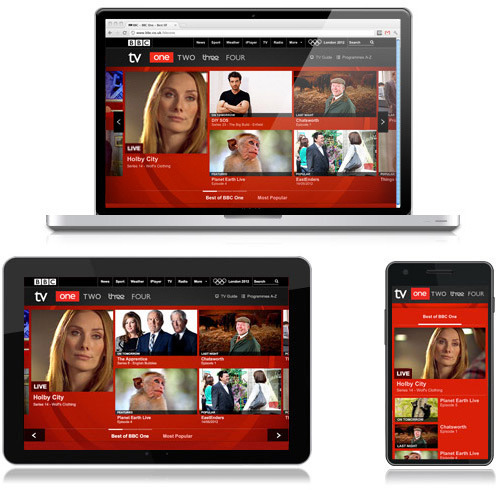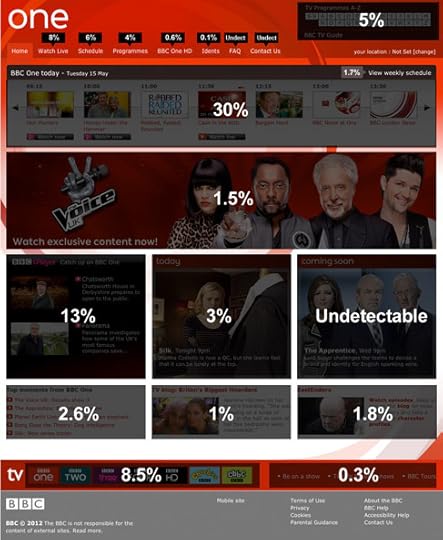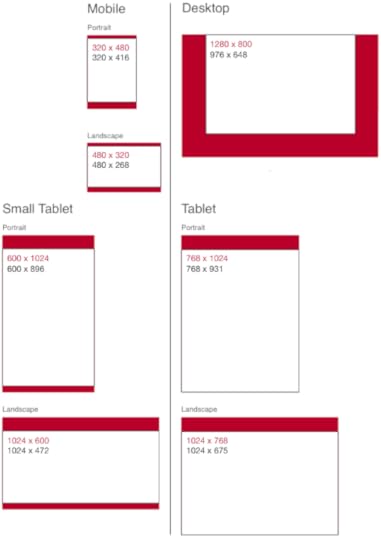A refresh of BBC's TV channel homepages

The same BBC One homepage on desktop, tablet, and mobile
Hello, my name is Dave Killeen and I am the Executive Product Manager for TV & iPlayer on PC and mobile web platforms.
Today sees the relaunch of three of the BBC's channel homepages (BBC One, BBC Two, BBC Four; BBC Three relaunched last week) and in this post, I would like to give you an overview of what we set out to achieve and how we went about doing so.
How the purpose of channels homepages has changed
When the team relaunched these channel homepages nearly four years ago, how people interacted with the web and what people expected of it was quite different. BBC iPlayer was less than a year old and accessing the web through a mobile device was also in its relative infancy; Apple's App Store was 4 months old and Google's Android platform was still in beta.
Four years on, BBC iPlayer continues to grow from strength to strength with approximately 2bn requests served to audiences last year and 1 in 4 online users in the UK accessed it last week. And mobile web usage in that time has seen equally spectacular growth with nearly 1 in 3 people who visited the BBC last week doing so on a mobile or tablet device- all 22m of them!

The old BBC homepage had two promotional slots showcasing content on BBC iPlayer
How times have changed
As you can see from the layout of the previous channel homepages above, they were built with the planning of 'offline' TV viewing being front and centre, with little real estate given to showcasing the breadth of channel content that you could consume right there and then.
Where the few opportunities did exist for our editorial colleagues in Vision to curate and promote, it was quite a manual task to do so and as you can see from the following heatmap, it was not the most efficient use of people's time.

Heatmap showing the percentage of people that clicked through the various links on the page
The opportunity
This refresh opportunity, therefore, was for a much-improved channels homepage presence that would allow each channel to stand its ground uniquely and showcase the breadth of content that it produces in a way which was simply more efficient and a great deal more engaging for audiences.
And with nearly 350 different mobile devices accessing the BBC website last week, the other opportunity (and challenge!) for the team was to build this in a way which worked just right across as many of these devices as possible - each with their own unique way of displaying content depending on screen size. Gone are the days of having to build a website for one screen!
The approach - serendipitous discovery
Showcasing the breadth of content unique to that channel in a way which would deliver simple and serendipitous discovery was a key editorial goal.
The team devised a logic to blend different automated feeds of content from BBC iPlayer (most popular, most shared by audiences, popular content that is about to fall outside the catch-up window (labelled 'Don't Miss')) along with links to live programming and a sprinkling of manually-curated items (labelled 'Featured') that together would achieve this goal of a serendipitous browsing experience.
That was the easy part!
The approach - responsive design
More challenging for the team was building this product responsively so that it would work on the majority of smart mobile and tablet devices, regardless of screen size.
This project was the first here at the BBC that would be built responsively from mobile right up through to desktop. Whilst hugely exciting for the team, it also meant that we did not have other product teams in the business that we could lean on for advice and lessons that they would have learnt along the way. In fact we are still on a learning curve!
In the end, we settled on a range of breakpoints (layouts), that we felt would work for the majority of devices that access the BBC today and we developed it in a way that allows us to review (or respond!) as the mobile device market evolves with the arrival of new and promising handsets.

The settled upon breakpoints (for now!)
The result and our next steps
Last year, we set out three strategic goals for the TV and iPlayer product portfolio:
Beyond Catch-up
Beyond PC
Beyond Tech-Savvy
We want to position TV and iPlayer as more than just catch-up, to make it available on as many devices as possible and for it to appeal to as wide an audience as possible.
With today's refresh, we have a stronger shout to live programming, to archive collections (BBC Four) and to web exclusive content (BBC Three). Mobile and tablet devices have been taken in to consideration and the user interface across these three platforms is one that is intuitive for mainstream users.
My Vision colleague Dan Taylor, from the editorial side of the business talks through the various features made available in more detail. We hope you agree with us both that these new channels homepages are a great step in the right direction and that they do a much better job of allowing a more varied breadth of channel specific content to bubble up to audiences.
Just as we have been able to extract a heatmap of usage of the old channels homepage design, we will be keeping a close eye on the usage data that flows through in the coming months and plan on making tweaks along the way based upon this and - of course - your feedback. Do let us know what you think!
Dave Killeen is the Executive Product Manager for TV & iPlayer on PC and mobile
BBC's Blog
- BBC's profile
- 28 followers



